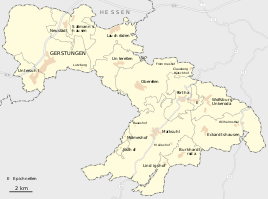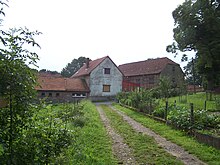Clausberg (Gerstungen)
|
Clausberg
community Gerstungen
Coordinates: 50 ° 57 ′ 43 " N , 10 ° 14 ′ 56" E
|
|
|---|---|
| Height : | 380-400 m above sea level NN |
| Postal code : | 99834 |
| Area code : | 03691 |
|
Clausberg in the central municipality
|
|
Clausberg is a district of Oberellen in the Wartburg district ( Thuringia ) and belongs to the unified municipality of Gerstungen .
history
Clausberg was probably created in the early Middle Ages as a manor and rest area for travelers. It is about 400 m above sea level on the Rennsteig . The Via Regia once led through the town, which until 1920 was in an exclave of the Duchy of Saxony-Meiningen and belonged to the Salzungen office .
It has always been part of the village of Oberellen and was therefore initially owned by the country nobles , who also owned Oberellen. Around 1800 the manor consisted of two houses with six inhabitants and belonged to the Eisenach Secret Council and Vice Chancellor Baron von Damnitz together with the domain treasury of the Duchy of Saxony-Meiningen. From 1861 the estate was the sole property of the von Donop family . In 1888, Dr. med. Roderich Zeiss, co-founder of the glass engineering laboratory Schott & Genossen , the Clausberg.
At the end of the 19th century the manor burned down completely twice. After the second fire on New Year's Eve 1899/1900, the owner at the time, Karl Heiligenstadt, a banker from Berlin, had a forest villa built outside the estate. After Hermann Ernst Moritz Arndt Meyer, a descendant of the publisher Joseph Meyer , had acquired the estate in 1910, he had the "Villa Heiligenstadt" torn down and between 1911 and 1913 a neoclassical villa was built that was popularly known as the "Meyer Villa". In 1925, the Bochum secret councilor Karl Ernst Korte bought the Clausberg and bequeathed it to his wife Marie Korte in 1935. The estate was owned by Dr. Hans Korte, who later became a partner in the Gustav Kiepenheuer publishing house , managed it. In 1927 he hired the manager Rudolf Eulitz, who, together with the pig master Friedrich Eilers, set up a breed of German refined country pigs . The widow Korte sold the property in 1937 to the Eisenach doctor Götz Klages and his wife.
After the Second World War , Götz Klages' share was expropriated in the course of the land reform in 1946 and fell to the state of Thuringia. However, the wife could not be expropriated because she was a citizen of the United States and therefore had to be paid off in 1951. In 1949, the Clausberg became a state-owned estate , which from 1951 belonged to the German Academy of Agricultural Sciences (from 1972 Academy of Agricultural Sciences of the GDR) in Berlin as the Clausberg research center . In the 1950s and 1960s, several residential buildings were built on the grounds of the property for the employees of the research facility; the listed villa served as the facility's headquarters. After the fall of the Wall there was a branch of the Thuringian State Institute for Agriculture there until the end of 2008 . The "Meyer Villa" has been up for sale since then and was sold in 2012.
Population development
Around 1810 six people lived on the Clausberg estate; on December 1, 1910, the village had 20 inhabitants. In 2017 the population was around 60.
Individual evidence
- ^ Duchy of Saxony-Meiningen (ed.): Contributions to the statistics of the Duchy of Meiningen . Kesselring, Meiningen 1838, p. 9 .
- ↑ Ernst Julius Walch: Historical, statistical, geographical and topographical description of the royal and ducal Saxon houses and lands in general and of the Saxe-Coburg-Meiningian house and its lands in particular . Schneider and Weigel, Nuremberg 1811, p. 255 .
- ↑ Donop, Barons . In: Ernst Heinrich Kneschke (Ed.): New general German nobility lexicon . Second volume. Friedrich Voigt, Leipzig 1860, p. 547 ff .
- ^ Friedrich Schomerus: History of the Jena Zeisswerk, 1846-1946 . Piscator-Verlag, Stuttgart 1952, p. 108 f .
- ↑ Population of the Duchy of Saxony-Meiningen, Meiningen district. Register of municipalities in Germany 1900, accessed on March 26, 2009 .





